High Frequency Trading Next Door - Part V (Final)
- Transfer
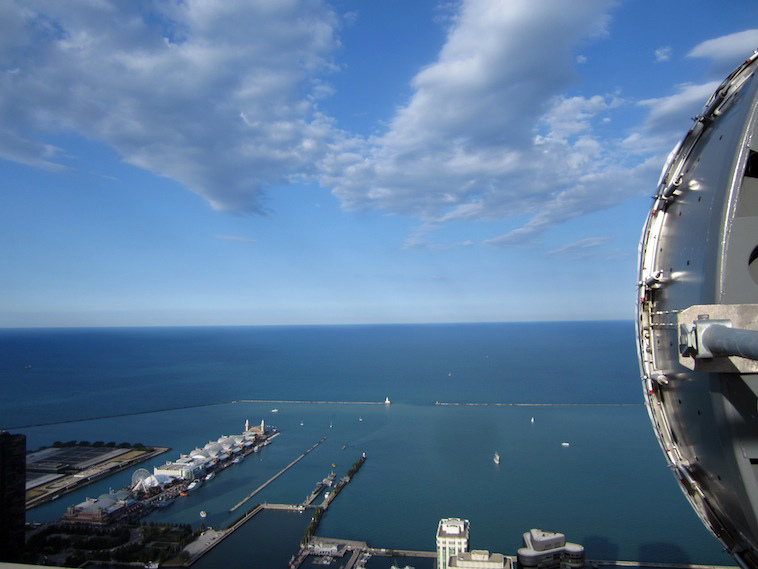
Note transl .: This is the last part from the material “High-frequency trading in the neighborhood” about HFT trading in Europe and the use of microwave radiation to transmit exchange information. In this part, the author will talk about what other military facilities (besides NATO facilities) are currently used in Europe for the benefit of HFT trading, as well as what are the most likely technologies to provide exchange information transfer in the future: the last chapters of “High-frequency trading on Neighborhood ”is dedicated to the Hibernia Atlantic project, plans to build intermediate“ nodes ”with data centers between exchanges and ... Google balloons.
Previous parts
The Past, Part III: The Royal Armed Forces of Great Britain
The story would not be complete if I did not say a few words about the Royal Armed Forces and the Chain Home radar detection system. Chain Home was a network built before and built during the Second World War by British troops to locate German aircraft (see map) The most famous of the towers built were probably the Three Sisters in Swingate, established in 1936 (this is how NATO and US Army networks could use these towers to “cross” the English Channel in 1960-1970). One tower was dismantled in 2010 (due to instability), but on one of the two remaining can be found the antennas of several competing HFT companies: McKay Brothers, Optiver and Jump Trading. Thanks to the Houtem tower, Jump no longer needs a tower in Swingate to reach Basildon [see Part II ], but I am sure that the Chicago firm still needs it to send signals to Slough.

If you want to know more about the history of these towers, just check out the applicationfor construction work filed by Jump Trading when it requested permission to install antennas. Surprisingly, the Chain Home system passed from Swingate to Dunkirk ... where you can find other HFT companies (McKay, Latent, Optiver, Custom Connect). Thus, two companies (at least): McKay Brothers and Optiver, use the route, which is the same microwave signal transmission route created by the Royal Armed Forces in the 1930s:
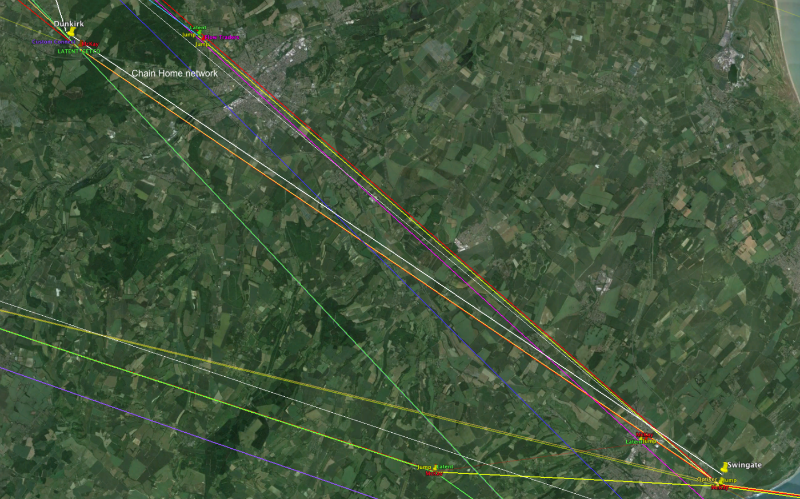
Towers in Swingate and Dunkirk are very famous in the UK. Due to their role in World War II, they were included in the list of the National treasure of England. Both towers are now historical monuments, and it is unfortunate that the two HFT firms, Custom Connect and Jump Trading, were quite disrespectful of history: I wrote in Part IIIabout Jump's apology for installing their “plates” in Swingate “before submitting a construction application” (in their own words ), and then I found out that Custom Connect installed their antennas in Dunkirk without permission. As one of the employees of the competing HFT company said to me, “at the monument of the Second World War it is a criminal offense” ...
The Future, Part I: Hibernia Atlantic
The U.S. Army, NATO and the Royal Armed Forces built many towers in the second half of the 20th century, and these towers are now filled with antennas that belong to various HFT providers. The Houtem Tower was sold to Belgium in 2006, as the U.S. Army found a more profitable technology: fiber optic cable. Towers that transmit microwave signals within line of sight have attracted the attention of new customers (high-frequency traders), since in this case the delay time is shorter than when using cables. I tried to find maps of fiber-optic networks laid between London and Frankfurt (to compare them with the routes of microwave communication networks), I even contacted some network service providers, but did not receive an answer (" trade secret ").
Once I looked at a large and similar map of London’s fiber optic networks on a wall, but since the action took place on the trading floor of one of the largest and most active players in the market, I was forbidden to take pictures. Using Google Images, you can find maps of providers such as euNetworks , but their schemes are too simplified, and, generally speaking, you can not see the real route of laid cables. There is only one exception: on the Zayo website you can find various cable networks under the control of the company. Naturally, the shape of the London-Frankfurt route is far from a straight line:
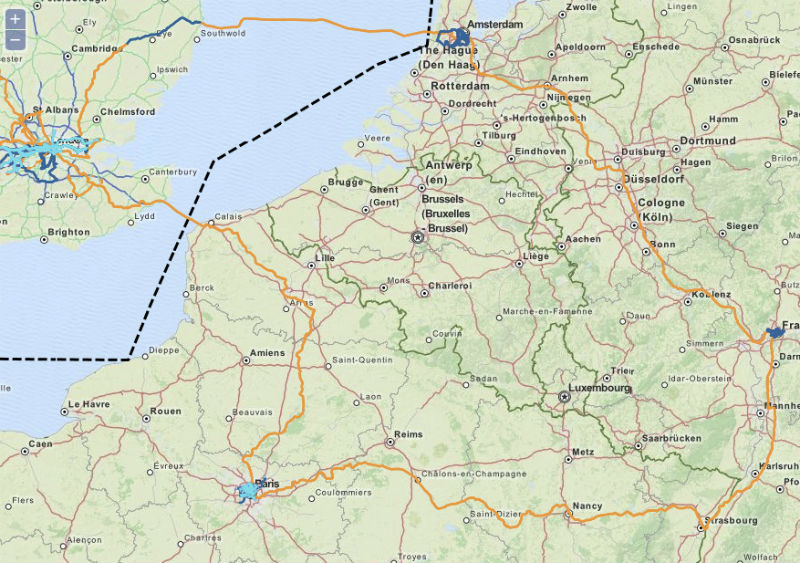
Since the combined lines of various types of networks are called “neighborhood”, let us pay attention to the neighborhood in Cornwall in the south of England. At this point, the continental routes of HFT radio relay links terminate and converge with the fiber optic cables needed to cross the Atlantic Ocean. I made a mistake in the previous parts of this section: here we need not one but two cables, and it seems that HFT companies do not use the same cables to cross the ocean.

The last antennas of the radio relay network of Jump communication lines are located at the Skewjack cable-laying station. According to Andrew Bloom’s amazing book “ Pipes ”, locals call this place “skewjack” because surfers set up camps here (read this interesting interviewto understand why surfers are compared to “ trying to catch a wave ” HFT algorithms, and also see this old post [French] on the role of surfers in HFT advertising). A FLAG Atlantic 1 ( FA-1 ) cable , owned by Reliance, is laid to this station .
A curious fact: if you remember, a company called Perseus Telecom is a provider of wireless services for various HFT companies in Europe; Perseus does not (at the moment) have any networks, but they rent part of the Jump frequency range (see Part II ), so it’s clear that Perseus is resellingFA-1 cable to its customers. I don’t know for sure, but it is likely that Perseus customers could purchase both a network of radio links from Frankfurt to Cornwall and an FA-1 cable from Cornwall to the United States.
The proximity of Jump Trading and Perseus may explain why Jump competitors (at least Optiver and Vigilant) used another cable called Atlantic Crossing 1 ( AC-1 ), whose slogan reads: “One planet. One network. " They say that it is faster than the FA-1. The cable laying station is called the White Sands Cable Station, and a detailed description of the facility can be found in Pipes , where Andrew Blum writes about “ one rack with the inscription SLAU”- that is, owned by the White Sands-Slough cable network.
However, high-frequency traders no longer need it, since they use microwave radiation to save a few milliseconds between two points. In this regard, both of these Cornwall stations are likely to become history soon. As I wrote in Part III , a new cable is being laid between the UK and the USA: the famous Project Express , owned by Hibernia.
Hibernia - a major provider in the world of finance : hereYou can find different locations for their cables. The “old” AC-1 cable offers transatlantic communications in 65 milliseconds, and Project Express supposedly reduces this time by 6 milliseconds (which is why my book is entitled “6”). A cable of 4,600 kilometers was supposed to be laid by 2012, but Hibernia had problems: the main one was the cybersecurity problem that arose through the fault of the Chinese contractor Huawei. Project Express resumed operations in July 2013, and thanks to Herald Business , we know that the British cable-laying station is located in Brin (incidentally, recentlyThe United States Federal Communications Agency, the communications regulatory authority, has granted permission to access Hibernia LLC to KCK Limited). So all trading firms that use microwave radiation to get to Cornwall have a little problem: Brin is not in Cornwall, but in Somerset; this means that all the routes of radio-relay communication lines from London (or Dover / Swingate) to Cornwall will be in some sense absolutely useless: But I made another mistake. Various industry informants (and one journalist) told me that Hibernia will not give permission (at least for now) to install parabolic antennas at a station in Brin. I tried to find out more about it, but the only answer was “ if you want, believe it or not.

". People know, but do not speak. I sent a letter to Hibernia but received no reply. Other informants later said that Hibernia could finally agree to install antennas in Brin.
One way or another, whatever the truth, as I explained earlier, various competing HFT companies were waiting for a new Project Express cable and ordered licenses / frequency ranges on different towers between Slough and Brin. In the end, I found out what is likely to be the exact location of the Project Express cable-laying station in Brin ; it will look like this:

Then I turned to my card, and it's just unbelievable ... Guess who owns the Ofcom license right at the site of this station? Jump Trading:
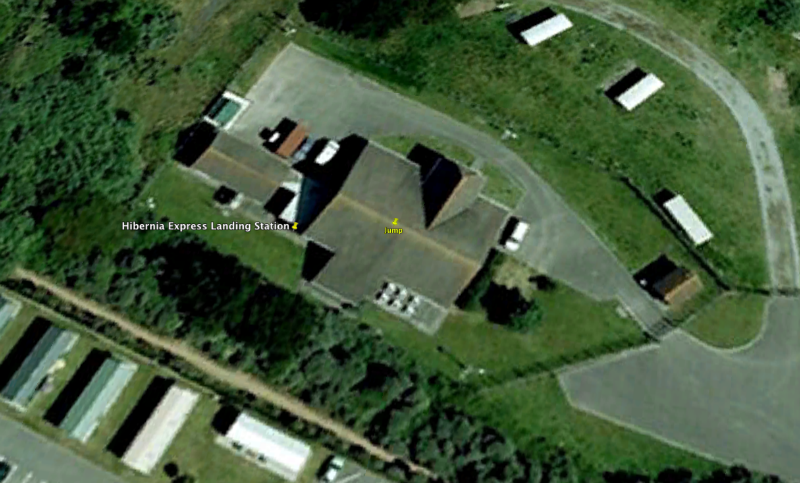
Ofcom license was issued on July 24, 2013, that is, 4 months after the termination of work on Project Express (due to Huawei) and 13 months before their renewal. Interesting timing. Hibernia announced that the new cable will be available from September 2015. If the company installs its antennas there, then the future of microwave links in Europe may be connected with Brin. Wait and see.
The Future, Part II: Ending the Neighborhood?
Trading firms need communication networks only because trading centers (engines connecting buyers and sellers) are widespread throughout the world. That is why some firms need to transmit microwave signals between Chicago and New York, or between London and Frankfurt, some - to lay optical fiber between Europe and the USA, or between the USA and Asia, etc. It's all about geography. At the end of my book, I briefly summarized all these issues, mentioning a theoretical article by Alexander Wissner-Gross (Harvard / MIT) and Cameron Freer (MIT), entitled “ Relativistic Statistical Arbitration ”, published in 2010 in Physical Review .
I will not go into the details of statistical arbitrage (I will consider it in my next issues), the article is interesting for its ideas about trading and space. In short: trading algorithms are now in close proximity to exchange machines / engines bringing together buyers and sellers (proximity in data centers), so orders are executed faster (in about 200-500 microseconds); but, nevertheless , the data must be transferred from one exchange to another. Wissner-Gross and Freer tried to imagine a world in which algorithms would be located in intermediate nodes between exchanges, that is, in optimal or midpoints between two trading centers.
"The server can be installed at computed points or nearby so that the delay time for the distribution of information between the server and the first trading center, in fact, will be equal to the delay time for the distribution of information between the calculated point and the first trading center."
The authors calculated the optimal locations (nodes) for “all pairs made up of the 52 largest exchanges” marked in blue on the map, red dots - exchanges (note that the article was published 5 years ago, since then the position of some red dots could slightly change ):

I really wanted to imagine trading servers floating in the middle of the ocean, so I decided to place both underwater fiber-optic communication lines around the world, and nodes on the map of Wissner-Gross and Freer on the cover of my book. Here is the “European” part of this cover:
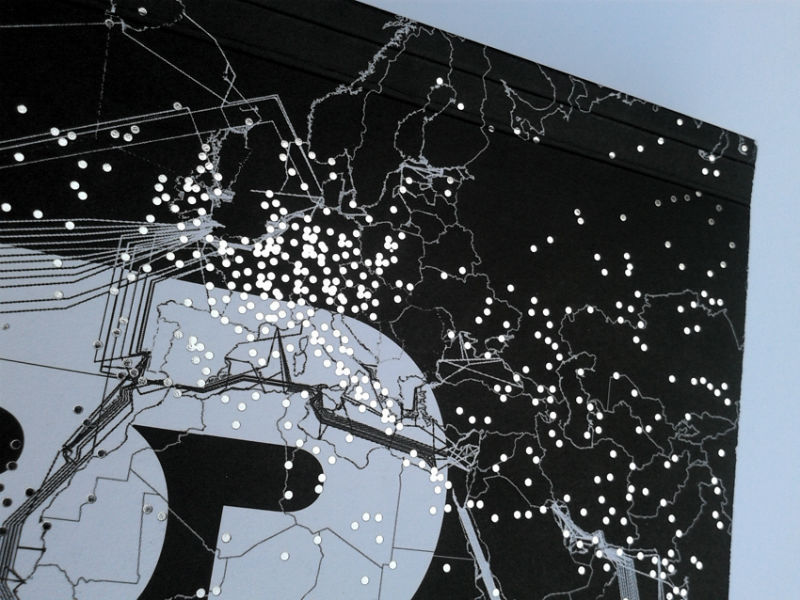
“Please note: while some nodes are located in areas with a high density of fiber-optic networks, others are located in the ocean or other loosely connected areas, which, ultimately, can contribute to the development of trading infrastructure with small delays in such remote, but advantageously located places ", - the authors write.
While I was writing this post, I realized that this theoretical study may not be so theoretical. And in fact, January 21, 2014 at the Massachusetts Institute of Technology Massachusetts Institute of Technology, MIT] The United States registered a patent with the title “System and Method of Relativistic Statistical Securities Trading”, and the names of the “inventors” were Alexander Wissner-Gross and Cameron Freer.
Here is a practical addition to their 2010 article with numerous details of what the future of trading can be. “The system may consist of a processor configured to calculate the location of the server, which will be located on the communication line between the first and second trading centers, at least partially located on the communication line”. This system would be better than the neighborhood:
“Placing a server at a point on the communication line between two trading centers in such a way that it will reduce the time delay for the dissemination of information when conducting“ distributed ”trades, perhaps will allow this type of transaction to be carried out more often, as well as“ distributed ”high-frequency trading at a higher speed than using the traditional approach, in which the server is located in one of the trading centers. ”
Here is one of the schemes presented in the patent:

Since the servers 116 must communicate with exchanges 102 and 110, they must be located in the data network 104 at point 108.
“In some embodiments, the communications network 104 may be wireless and utilize any suitable wireless technology to enable wire-less information transmission. Communication network 104 may transmit information using electromagnetic waves of any appropriate frequency. For example, frequencies from the radio, microwave, visible, infrared or ultraviolet ranges can be used. Communications network 104 may encompass any wireless technology for transmitting information, including satellites, transmitters, receivers, antennas, repeaters and / or radios. "
"Set pre-programmed computers on both sides of the connection would be too easy," - Uissner-Gross said in this interview, as a result of the neighborhood will be " arms race to reduce latency between two points. The next step will be the installation of [trading algorithms] in nodes . ” I remember my conversation with the CEO of one major microwave supplier company between Chicago and New Jersey; I found out that most of the company's customers require microwave radiation to collect data from one exchange (say CME [the Chicago Mercantile Exchange - Chicago Mercantile Exchange ] in Aurora) in order to transfer an order to another exchange (say NYSE [New York Stock Exchange - New York Stock Exchange] in Mahwah).
This means that most HFT companies need superfast networks to know what is happening here and there, and related algorithms based on these data can make decisions about buying and selling goods right on the spot - for example, an algorithm in Mahwah should receive information about what happens in Aurora with the E-mini S&P (ES) futures so that he can trade the SPDR S&P 500 ETF (SPY) in Mahwah. This is why data must be moved as quickly as possible between the two exchanges - due to the “arms race”.

If you are a trader or a client of the McKay Brothers radio relay network (as they say, the fastest), the minimum delay time that can be obtained between Machwah and Aurora will be 4.062milliseconds. In short, the idea of Wissner-Gross and Freer is to place trading algorithms somewhere in the middle between Aurora and Machwah (in the node), so that these algorithms can receive data in ± 2.031 milliseconds (this example is theoretical, and most optimal locations nodes, generally speaking, do not coincide with the midpoints of the paths, see patent). Since the authors registered the patent, and after they “ negotiated with financial companies to transfer the rights to [their] method ” in 2010, I suggested that their “System and method of relativistic statistical securities trading” may have a number of practical applications, so I wrote to Wissner-Gross and Freer to learn more about this.
They answered politely, but " at the moment they could not say anything about it ." What a pity! But a few days later I received a response from them and realized that in 2011-2012 both Alexander Wissner-Gross and Cameron Freerwere members of a panel of experts in a company called ... Hibernia. Isn't that amazing? I was curious, for the sake of laughter: if the system has potential benefits for trading companies, if the fastest connection is via a network of radio-relay communication lines, and if servers / trading algorithms should be on this line, this would mean that the algorithms can be placed on towers, it is so? Given that Belgium is in the middle of the London-Frankfurt route, this means that in the future my surroundings may be occupied with trading algorithms ...
The Future, Part III: Balloons or Tropospheric Radio Communications?
“If the trading centers of New York and London were connected by transoceanic fiber optic cable, it would be extremely difficult and expensive to place a server somewhere in the ocean,” Wissner-Gross and Cameron write in a patent document. Therefore, the question arises: how to place a server in the middle of the ocean? On a floating platform?
Today, a trading company can use networks of radio-relay communication lines between two points on the earth, but it is impossible to build a network with signal transmission within direct visibility between the UK and the USA - if you could not create any floating islands in the Atlantic Ocean, but it would be too difficult. That is why, at least for the moment, there are no other solutions than to extend the fiber optic cable across the ocean.
However, on September 23, 2014, Newswire PR wasit was announced that Windy Apple Technologies (WAT) plans to “ create a transatlantic service using advances in equipment design and innovative platform placement methods . The plans include the creation of high- and low-speed networks for low latency connections between New York and London, which gives WAT the opportunity to be both the first in the market and to receive significantly greater profit than transatlantic optical systems worth several billion dollars, the installation of which competing providers are currently engaged . ” What is meant here?
“We take great pleasure in turning incredible ideas into credible ones.”“, Said Alex Pilosov, CEO of WAT, who formed the first network of microwave links between Chicago and New York earlier in 2010 (only a month after the Spread Networks cable was commissioned). Some from the HFT / microwave industry said that “ Pilosov is like a typical Russian engineer who can build a space rocket with two pieces of chewing gum .”
Unfortunately, both WAT and Newswire PR do not reveal much of the details of these plans. “ The company's internal R&D program has thoroughly studied [...] the methods for deploying transmission platforms using aircraft, balloons and satellites .” The key, perhaps, is the word balloon: at a conference in Parislast December, McKay Brothers CEO Stefan Tych announced that the radio relay networks required by HFT companies would remain the fastest technology for 4-5 years until they were replaced by Google balloons .
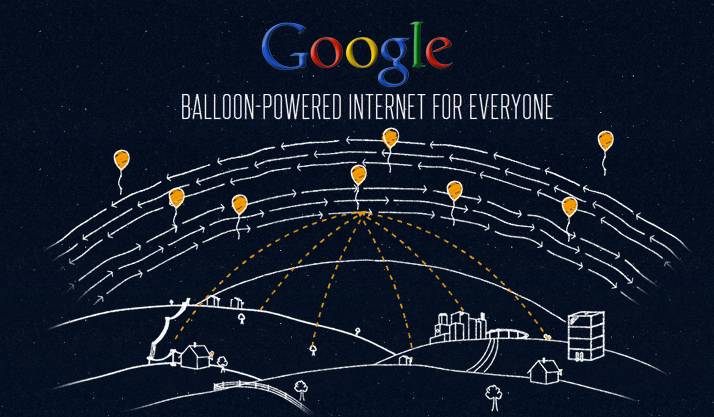
Honestly, I don’t quite imagine how you can build a network using balloons, but it seems to me (in simple terms) that the signal would be sent from an antenna located at the top of one exchange and would be received by an antenna placed on a stratospheric balloon, and then the signal would be sent back to Earth to another exchange. Will one balloon at high altitude be enough to cross the Atlantic Ocean, given that the Earth has the shape of a balloon? It is very doubtful (but such a balloon would be an ideal server location above the ocean if the Wissner-Gross and Freer system was ready for use).
Another detail can be found in my Twitter correspondence with an expert from a Belgian telecommunications provider who asked, “Have these HFT industry workers ever thought about tropospheric communication as a cheap and profitable alternative to various towers that transmit signals within direct line of sight. Alex Pilosov replied: “ We thought about it. In fact, this is precisely what prompted me to set up wireless communications over long distances . ” Interesting.
Tropospheric Us [ Eng. tropospheric scatter, troposcatter ] is a microwave radio technology that does not need towers to transmit a signal within direct line of sight. Instead of sending a signal from one tower to another, the tropospheric communication uses the troposphere as the area receiving the signal and transmitting it back to Earth, so that the signal can be received using the antenna:
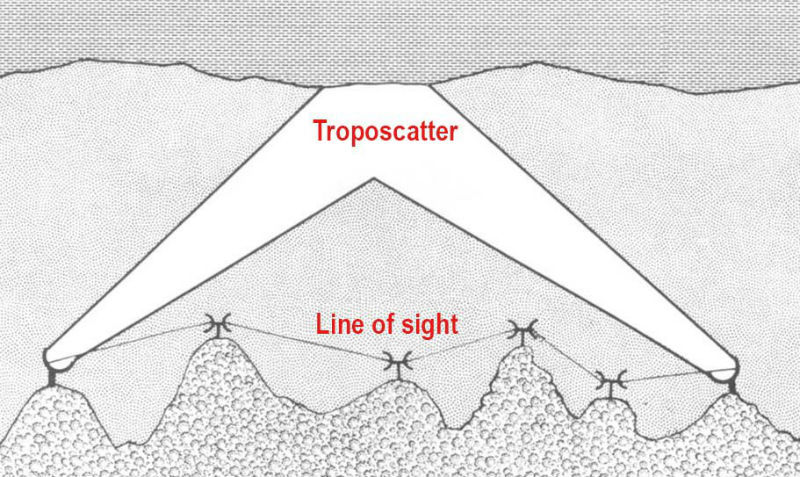
When using stratospheric communication technology, the signal can be transmitted over long distances (up to 1000 kilometers), and the transmitter and receiver do not need to “see” each other. This is amazing because most of the old networks of radio-relay communication lines that I talked about earlier (NATO's ACE High, the US Army’s Defense Ministry communications system, etc.) used tropospheric radio-relay communications — it would be interesting to see how these outdated military technologies will be used in high-frequency trading in the future. For tropospheric communication, antennas of a much larger size are needed than those that are now used in radio relay signal transmission networks within the line of sight. The photograph shows several abandoned tropospheric communication plates built for the NATO ACE High radio relay network in the UK:
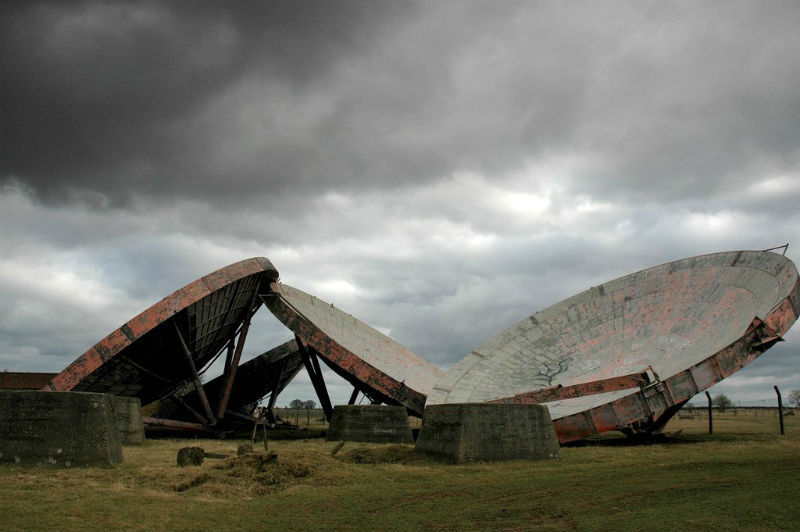
I don’t know, in fact, whether Windy Apple Technologies projects will use tropospheric communication and whether they will need such large antennas. We will see. But it’s clear that the arms race is not over (yet). High-frequency trading will again have to curb nature. “ I consider this kind of activity one of the possible justifications for the fact that the entire earth’s surface will have more automated capabilities ,” said Alexander Wissner-Gross in this interview. “And in fact the whole planet will become more developed.” I will end with this question: what does the Earth itself think about this?
